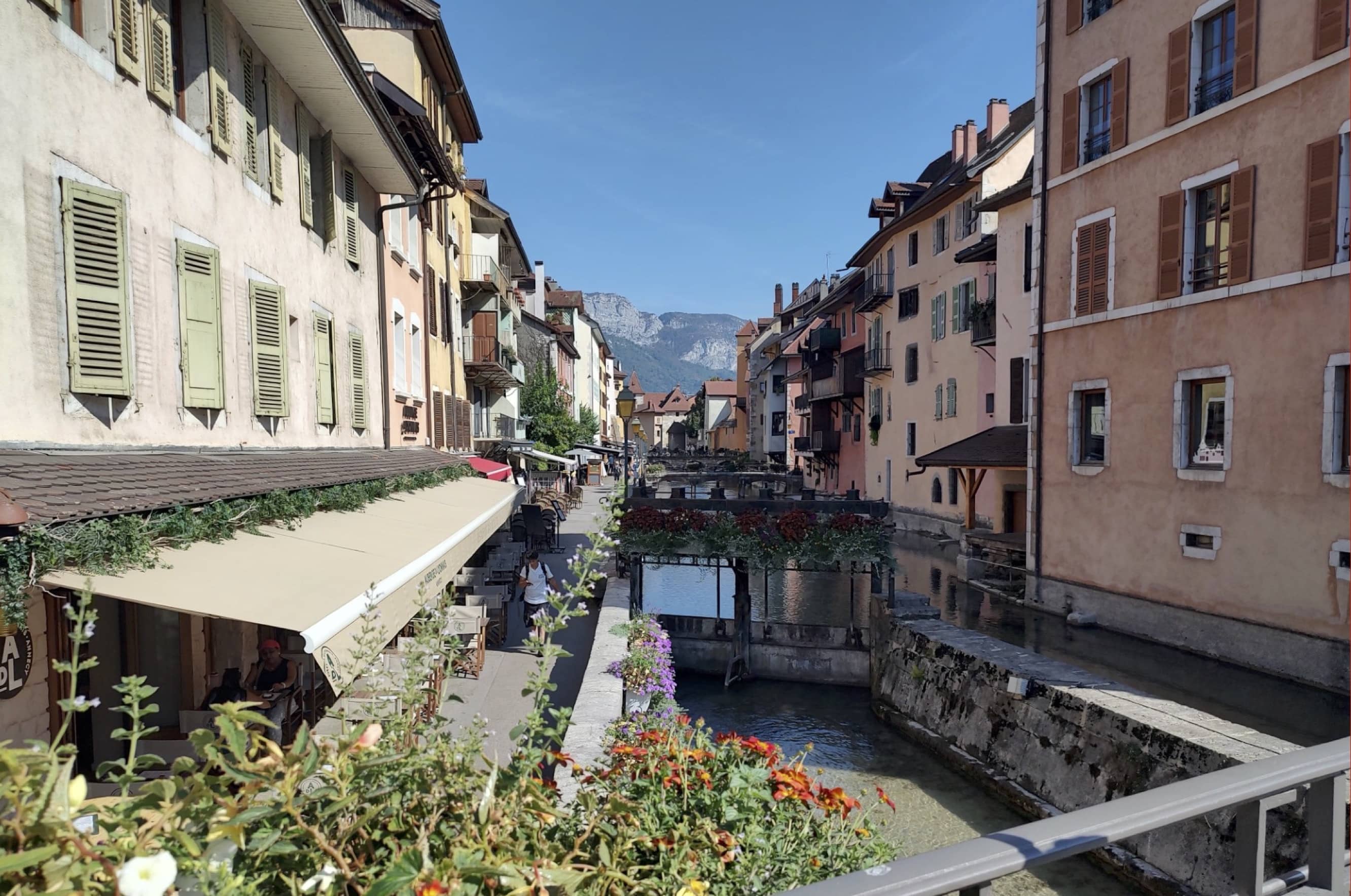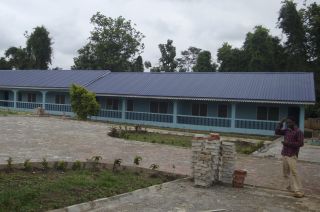
www.buildingsandcities.org/insights/commentaries/vernacular-lessons-mitigating-overheating.html
Vernacular Lessons for Mitigating Overheating

Important lessons for keeping cool in summer can be adapted from cities with hot climates
Samantha Organ (University of the West of England), Stephanie Organ (science communicator) and Quentin Deronzier (NTN Europe) respond to the Buildings & Cities special issue 'Alternatives to Air Conditioning: Policies, Design, Technologies, Behaviours' by considering how vernacular architecture and modern technology could provide solutions for the increasingly severe problem of summer overheating in European cities.
Introduction
In 2023, Europe experienced the 'Cerberus Heatwave' and a rising number of extreme weather events occurred across Europe and the world, with longer-lasting heatwaves leading to events such as wildfires. The European Environment Agency (EEA 2022) highlighted that heatwave events are responsible for between 77,000 and 129,000 deaths across 32 EEA member countries from 1980 and 2020. In 2022 alone, it has been estimated that 61,672 people in Europe died as a result of heat between 30 May and 4 September (Ballester et al. 2023). Additionally, an ageing population and increasing urbanisation will make the population more vulnerable to heat and could lead to increased use of active cooling in buildings which has an energetic, financial and climate cost.
Buildings can provide protection from heat at low energy costs if they are appropriately designed, constructed, maintained and renovated. Vernacular buildings are often rated as thermally inefficient. However, in reality they can provide useful insights into the use of passive measures. As the climate warms, the vernacular architecture of warmer countries may provide useful suggestions for future adaptation measures.
Architecture and overheating in Annecy
Annecy is situated in the South of France in the Alps Mountains, 22 miles from Geneva and has been nicknamed 'Venice of the Alps' referring to its network of canals. Like other cities in the region, Annecy is already being impacted by a changing climate. Analysis by the DLR Earth Observation Center (2023) has identified 'exceptionally low snowfall' in winter and snow deficits in the Alps compared with the previous 38 years due to milder temperatures and lower levels of precipitation. During the summer of 2023, Annecy saw temperature highs of 38˚C (23 and 24 August) (AccuWeather, n.d.). Météo France's La Drias project suggests that of the 70 most populated cities in France, Annecy is projected to have the greatest increase in the number of 'extra' days and nights categorised as 'abnormally hot' (more than 5˚C warmer than current normal temperatures) in July - August between 2040 and 2070 (The Connexion 2022). Indeed, past research by Durand et al. (2009) has already shown a temperature increase of 1.5˚C in Annecy between 1958 and 2002, similar to Nice and Villard-de-Lans.
There are many listed buildings in Annecy, and its buildings generally are among the top 10% least thermally efficient in France according to Energy Performance Certificates (EPCs) (Nedar 2022). This is partly due to the Alpine region having increased heating demand, which is taken into account by the EPC, but also because they are older buildings with low renovation rates, thus not benefiting from modern thermally efficient construction materials. In France, the Directorate General of Heritage and Architecture within the Ministère de la Culture is responsible for the identification, study, protection, preservation and enhancement of heritage (Ministère de la Culture 2023). There are also zones that carry protected status, which are subject to planning constraints to maintain the aesthetic, architectural or historical aspect of an area. Additionally, properties within 500m of a historic building or monument, properties within a national park or listed buildings may be subject to further regulations (FrenchEntrée 2021) including avoiding irreversible changes to building facades without first considering the heritage. Thus, the historic architecture of Annecy is likely to remain for some time to come. Yet its buildings possess many features, often missing from modern buildings, that mean they have the potential for internal environments that are thermally comfortable and healthy.
Vernacular solutions to overheating
Despite the potentially significant worsening of exposure to overheating, the vernacular architecture in Annecy may provide some refuge for their occupants. Properties in the Old Town have features which mitigate overheating and promote passive cooling. For instance, while chalets in the surrounding mountains have been finished in dark-coloured timber, buildings and paved surfaces in the Old Town were finished primarily in lighter colours to avoid the absorption of some of the heat during daylight hours. Further, buildings in the Old Town are of thermally heavy construction, mitigating peak temperatures by acting as thermal buffers. Additionally, some of the older buildings such as the Château d'Annecy and the Palais de l'Île include courtyards, which contribute to passive cooling. Passive cooling is typically taken to mean the use of natural processes (e.g., ventilation, solar shading) to reduce indoor temperatures. This may or may not incorporate minor mechanical equipment where it improves cooling performance (Prieto et al. 2018). Buildings in the Old Town also use louvered shutters to enable windows to remain open to increase passive ventilation and cooling, particularly at night. These buildings have ceiling heights up to 2.6m while the French building regulations minimum is 2.2m (Appolloni & D'Alessandro 2021). Victorian housing in the UK as well as more modern housing in Italy and Portugal were built with ceiling heights of between 2.6m to 3m (Coates 2022) enabling thermal stratification and for hot air to collect above the occupied space and assist in cooling and comfort (Blennerhassett 2023). Traditionally colder countries appear to have marginally lower heights (Appolloni & D'Alessandro, 2021).
Complementary modern technological solutions
Annecy also provides examples of the use of renewable technology for heating and cooling. One of the local monasteries, Tamié Abbey, uses whey, a waste product from their cheese production, to produce biogas for hot water. In addition to reducing energy demand from the grid, the use of biogas heating technology reduces transport demand because less waste needs removing from site. In addition to lowering the energy demand from the grid, it decreases transport costs and the carbon associated with transportation (BipiZ 2008). Permission has also been granted to create and operate a heating and cooling network serving Annecy's Trésums district via a heat pump and exchanger (BAT Info 2020). This will be achieved by drawing water from 20m deep in the lake where the temperature is at a constant 7˚C throughout the year. This water will supply heat pumps in an urban heat network and serve the buildings within the district before the water is returned to the lake. When cooling is required, exchangers will enable the water to cool a hotel, senior residence and nautical centre. This would avoid the need for individual air conditioning units, which Godefroy (2023) suggests mitigates the risk of fuel poverty, reduces cooling needs, improves the resilience to failure of the main electricity grid, and avoids heat emission from cooling technology which can contribute to the urban heat island effect. Thus, Annecy has improved its potential to keep its citizens comfortable in an increasingly warm climate by taking the best of both vernacular design and modern technological solutions.
Final reflections
Europe is experiencing a changing climate, seeing an increase in temperatures. Lessons can be drawn from vernacular architecture, passively enhancing indoor thermal comfort. The wider built environment can provide increased comfort through aspects such as surface colours to mitigate heat absorption and green infrastructure (i.e. trees) to provide shade and cooling. At an individual building level, features to enhance indoor comfort included the use of heavy thermal mass, louvered shutters, greater ceiling heights, and the incorporation of courtyards to improve ventilation or provide a thermal buffer. Whilst Annecy's buildings may continue to be within the top 10 least thermally efficient in France, its traditional building features enhance indoor thermal comfort. Annecy has also demonstrated how these principles can be married with the potential role of renewable technology to improve the quality of life of its residents, a lesson which may be useful for other cities facing a future of increasingly severe overheating risks.
References
AccuWeather. (no date). Annecy - Haute-Savoie. https://www.accuweather.com/en/fr/annecy/136553/august-weather/136553?year=2023
Appolloni, L. & D'Alessandro, D. (2021). Housing spaces in nine European countries: a comparison of dimensional requirements. International Journal of Environmental Research and Public Health, 18(8). https://doi.org/10.3390/ijerph18084278
Ballester, J., Quijal-Zamorano, M., Méndez Turrubiates, R. F., Pegenaute, F., Herrmann, F. R., Robine, J. M., Basagaña, X., Tonne, C., Antó, J. M., and Achebak, H. (2022). Heat-related mortality in Europe during the summer of 2022. Nature Medicine, 29, 1857-1866. https://doi.org/10.1038/s41591-023-02419-z
BAT Info. (2020). The water from Lake Annecy will heat and cool the future Trésums district. https://batinfo.com/en/actuality/the-water-of-lake-dannecy-will-heat-and-cool-the-future-district-of-tresums_14860?id=
BipiZ. (2008). The TAMIE ABBEY recycles the biogas from its cheese dairy. https://www.bipiz.org/en/csr-best-practices/the-tamie-abbey-recycles-the-biogas-from-its-cheese-dairy.html
Blennerhassett, E. (2023). Providing adequate thermal comfort in a hotter world. [commentary] Buildings & Cities. https://www.buildingsandcities.org/insights/commentaries/adequate-thermal-comfort.html
Coates, A. (2022). What's the UK's standard ceiling height for houses, extensions and loft conversions? Designs in Detail. https://www.designsindetail.com/articles/whats-the-uks-standard-ceiling-height-for-houses-extensions-and-loft-conversions#:~:text=The%20average%20ceiling%20height%20of,of%20natural%20light%20and%20ventilation
The Connexion. (2022). Annecy, Lyon, Avignon: The French towns most at risk of rising heat. https://www.connexionfrance.com/article/French-news/Annecy-Lyon-Avignon-The-French-towns-most-at-risk-of-rising-heat
DLR Earth Observation Center. (2023). Earth observation data reveal snow deficits in the Alps. https://www.dlr.de/eoc/en/desktopdefault.aspx/tabid-18823/30125_read-83952/
Durand, Y., Laternser, M., Giraud, G., Etchevers, P., Lesaffre, B. and Mérindol, L. (2009). Reanalysis of 44 yr of climate in the French Alps (1958-2002): methodology, model validation, climatology, and trends for air temperature and precipitation. Journal of Applied Meterology and Climatology, 48(3), 429-449. https://doi.org/10.1175/2008JAMC1808.1
European Environment Agency (EEA). (2022). Cooling buildings sustainably in Europe: exploring the links between climate change mitigation and adaptation, and their social impacts. https://www.eea.europa.eu/publications/cooling-buildings-sustainably-in-europe
FrenchEntrée. (2021). Building and renovation in France: protected zones, listed & heritage buildings. https://www.frenchentree.com/french-property/renovation/building-and-renovation-in-france-protected-zones-listed-heritage-buildings/
Godefroy, J. (2023). Practical approaches to cooling: a UK perspective. [commentary] Buildings & Cities. https://www.buildingsandcities.org/insights/commentaries/practical-approaches-cooling.html
Ministère de la Culture. (2023). Directorate-General for Heritage and Architecture. https://www.culture.gouv.fr/en/Know-us/Organisation-du-ministere/Directorate-General-for-Heritage-and-Architecture
Nedar, S. (2022). Passoire thermique: classement 2022 ville et département. Hello Watt. https://www.hellowatt.fr/blog/classement-passoires-thermiques/
Prieto, A., Knaack, U., Auer, T., Klein, T. (2018). Passive cooling & climate responsive façade design: exploring the limits of passive cooling strategies to improve the performance of commercial buildings in warm climates. Energy and Buildings, 175, 30-47. https://doi.org/10.1016/j.enbuild.2018.06.016
Tasting Table. (2022). The Fascinating French Monastery Powered By Cheese. https://www.tastingtable.com/1008076/the-fascinating-french-monastery-powered-by-cheese/
Latest Peer-Reviewed Journal Content
Designing for pro-environmental behaviour change: the aspiration–reality gap
J Simpson & J Uttley
Lifetimes of demolished buildings in US and European cities
J Berglund-Brown, I Dobie, J Hewitt, C De Wolf & J Ochsendorf
Expanding the framework of urban living labs using grassroots methods
T Ahmed, I Delsante & L Migliavacca
Youth engagement in urban living labs: tools, methods and pedagogies
N Charalambous, C Panayi, C Mady, T Augustinčić & D Berc
Co-creating urban transformation: a stakeholder analysis for Germany’s heat transition
P Heger, C Bieber, M Hendawy & A Shooshtari
Placemaking living lab: creating resilient social and spatial infrastructures
M Dodd, N Madabhushi & R Lees
Church pipe organs: historical tuning records as indoor environmental evidence
B Bingley, A Knight & Y Xing
A framework for 1.5°C-aligned GHG budgets in architecture
G Betti, I Spaar, D Bachmann, A Jerosch-Herold, E Kühner, R Yang, K Avhad & S Sinning
Net zero retrofit of the building stock [editorial]
D Godoy-Shimizu & P Steadman
Co-learning in living labs: nurturing civic agency and resilience
A Belfield
The importance of multi-roles and code-switching in living labs
H Noller & A Tarik
Researchers’ shifting roles in living labs for knowledge co-production
C-C Dobre & G Faldi
Increasing civic resilience in urban living labs: city authorities’ roles
E Alatalo, M Laine & M Kyrönviita
Co-curation as civic practice in community engagement
Z Li, M Sunikka-Blank, R Purohit & F Samuel
Preserving buildings: emission reductions from circular economy strategies in Austria
N Alaux, V Kulmer, J Vogel & A Passer
Urban living labs: relationality between institutions and local circularity
P Palo, M Adelfio, J Lundin & E Brandão
Living labs: epistemic modelling, temporariness and land value
J Clossick, T Khonsari & U Steven
Co-creating interventions to prevent mosquito-borne disease transmission in hospitals
O Sloan Wood, E Lupenza, D M Agnello, J B Knudsen, M Msellem, K L Schiøler & F Saleh
Circularity at the neighbourhood scale: co-creative living lab lessons
J Honsa, A Versele, T Van de Kerckhove & C Piccardo
Positive energy districts and energy communities: how living labs create value
E Malakhatka, O Shafqat, A Sandoff & L Thuvander
Built environment governance and professionalism: the end of laissez-faire (again)
S Foxell
Co-creating justice in housing energy transitions through energy living labs
D Ricci, C Leiwakabessy, S van Wieringen, P de Koning & T Konstantinou
HVAC characterisation of existing Canadian buildings for decarbonisation retrofit identification
J Adebisi & J J McArthur
Simulation and the building performance gap [editorial]
M Donn
Developing criteria for effective building-sector commitments in nationally determined contributions
P Graham, K McFarlane & M Taheri
Join Our Community

The most important part of any journal is our people – readers, authors, reviewers, editorial board members and editors. You are cordially invited to join our community by joining our mailing list. We send out occasional emails about the journal – calls for papers, special issues, events and more.
We will not share your email with third parties. Read more



Latest Commentaries
COP30 Report
Matti Kuittinen (Aalto University) reflects on his experience of attending the 2025 UN Conference of the Parties in Belém, Brazil. The roadmaps and commitments failed to deliver the objectives of the 2025 Paris Agreement. However, 2 countries - Japan and Senegal - announced they are creating roadmaps to decarbonise their buildings. An international group of government ministers put housing on the agenda - specifying the need for reduced carbon and energy use along with affordability, quality and climate resilience.
Building-Related Research: New Context, New Challenges
Raymond J. Cole (University of British Columbia) reflects on the key challenges raised in the 34 commissioned essays for Buildings & Cities 5th anniversary. Not only are key research issues identified, but the consequences of changing contexts for conducting research and tailoring its influence on society are highlighted as key areas of action.